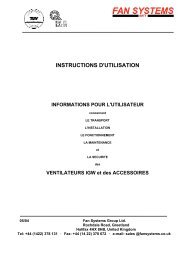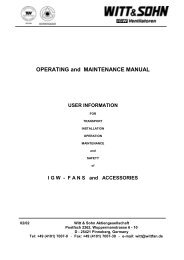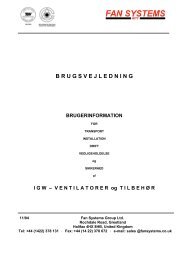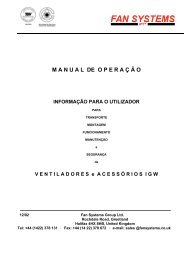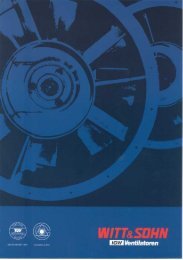OPERATING and MAINTENANCE MANUAL Jetfans and other Axial ...
OPERATING and MAINTENANCE MANUAL Jetfans and other Axial ...
OPERATING and MAINTENANCE MANUAL Jetfans and other Axial ...
You also want an ePaper? Increase the reach of your titles
YUMPU automatically turns print PDFs into web optimized ePapers that Google loves.
Fan Systems Group Ltd Tel: +44 (14 22 378 131Rochdale Road, Halifax 4HX 8HB, United Kingdom Fax: +44 (14 22) 371 672certified acc. to DIN ISO 900114. F I R E D A M P E R S14.1 SAFETY ASPECTSWe have carefully manufactured a solid <strong>and</strong> reliable product according to the state of the art. Product damage <strong>and</strong> personal harm can resultfrom insufficient maintenance. Excessive vibration may cause fractures leading to serious damage.Caution is necessary near moving parts. This applies to the damper blades <strong>and</strong> the driving <strong>and</strong>/or actuating mechanisms. A malfunction of thedamper blade lock might cause the blade to move unexpectedly due to its own weight, wind or air flow.14.2 TRANSPORTDuring transport only the specially provided lifting eyes are to be used as attachment points. When using forklift trucks the forks must not beallowed to damage the product. The lowering of the product should be carried out at the minimum lowering speed. Impact shocks, jerking <strong>and</strong>dropping can lead to deformations.14.3 MOUNTINGEnsure that the casing is not mechanically deformed or distorted in order to prevent a jamming of the damper blade or damage to <strong>other</strong>components. Fire dampers can only be used in the installation position for which they were ordered <strong>and</strong> designed (horizontal or vertical). Allmovable parts <strong>and</strong> all control <strong>and</strong> operating levers must be protected from corrosion, dirt <strong>and</strong> icing.14.4 INITIAL OPERATIONIn case of fire the damper is closed mechanically either manually by a spring mounted fusible link, by disconnecting the pressurized air supplyor the power supply. The purpose is to avoid the spreading of smoke <strong>and</strong>/or fire along the ducts. Normally the triggering temperature is set to70°C. Before the initial operation the casing is to be checked for foreign particles. The rotational direction is shown on the casing. The correctdirection can be verified through observation of the rotating parts.14.5 <strong>MAINTENANCE</strong> - GeneralFire dampers fulfil an essential function <strong>and</strong> must therefore be inspected <strong>and</strong> serviced regularly. The bearings are made of a stainless steelshaft (DIN 1.4571), with a loose fit inside a bushing of the same material. Lubrication is not required. However, every 6 months an operationalcheck should be done, during which the release mechanism should be tested a number of times so that a quick <strong>and</strong> faultless closing can beverified.The bearings must be inspected <strong>and</strong> cleaned if dirt or salt deposits from sea water spray are observed, e. g. using pressurised air or cleanwater. When painting, care must be taken to avoid paint restricting the free movement of the damper blade(s) <strong>and</strong> actuator(s). After a fire thefunctional capability of all parts must be inspected. Ensure that deformations due to heat have not impaired the tightness or the free movementof the damper. The release mechanism needs special attention during the inspection to ensure its operability.14.6 <strong>MAINTENANCE</strong> - Special instructions14.6.1 Manually operated fire damperCheck the ease of movement of the damper blade <strong>and</strong> the pin used to lock the manual lever. The manual operation can be a st<strong>and</strong> alonefeature or an addition to an automatic release mechanism. In the second case the manual lever has a special shape allowing the manualclosing of the damper irrespective of the automatic release mechanism.14.6.2 Fire damper with fusible link / thermo switchIn the event of a fire, when the temperature rises above approx. 70 degrees C, the soft solder melts <strong>and</strong> the fire damper releasesautomatically. The plunger pin of the catch on the adjusting element is freed, the damper blade falls in the closing direction <strong>and</strong> is locked intothe "CLOSED" position by the locking pin.A check is carried out by pushing the red button which simulates a thermal release. To check the soft solder melting piece, the inspection flapmust be removed <strong>and</strong> the soft solder melting piece taken out of the release device. Ensure that no outer damage is visible, then reload thespring <strong>and</strong> replace the soft solder melting piece.If the fire damper is to be put into service again after a release, a new soft solder melting piece must first be installed into the air shaft.Subsequently one must pull the locking pin out <strong>and</strong> move the h<strong>and</strong> lever to the "OPEN" position. To lock it into this position the plunger pin isagain pushed into the catch.14.6.3 Fire dampers with pneumatic cylinderThe fire damper is closed in the pressureless condition by a spring which is built into the compressed air cylinder. The closing procedure canbe triggered by one of the following actions:1. The temperature in the air shaft reaches the pre-set temperature <strong>and</strong> the temperature valve is actuated.2. Actuation of the h<strong>and</strong> valve on the fire damper.3. Interruption of the power supply to the solenoid valve i. e.: through the electrical temperature switch on the fire damper, halon release,emergency stop switch or failure in the electrical supply.4. Actuation of the main valve on the control system.5. Leak in the compressed air supply.The damper is closed by a spring built into the pneumatic cylinder. The system pressure should be checked. It should be between 2 <strong>and</strong> 10bar. The pneumatic cylinder rod must be cleaned regularly <strong>and</strong> be lubricated with a thin film of acid free lubrication oil. The seals in thepneumatic cylinder are self lubricating. The filter in the pneumatic air system should be checked <strong>and</strong> if necessary renewed. The filter housingshould be cleaned <strong>and</strong> the accumulated water drained.14.6.4 Fire damper with electric motorCheck whether the spring built into the electric positioning motor closes if the power supply is interrupted. This can occur if:1. The temperature in the duct reaches the pre-set temperature2. The power supply is switched off3. There is a fault in the power supply16




